Introduction
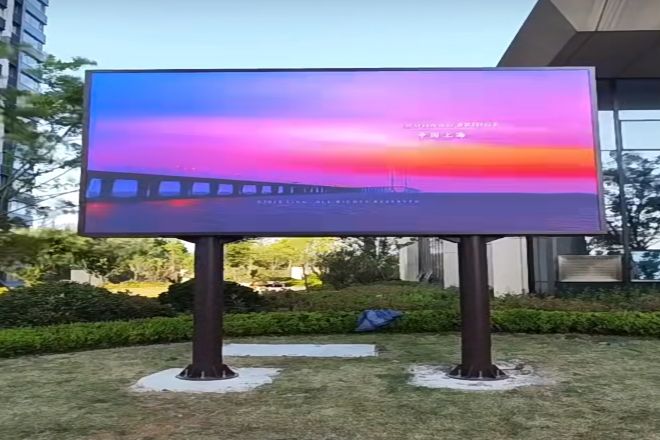
Avec le développement rapide de la science et de la technologie, Écrans d'affichage LED, as an important medium for modern information dissemination, are widely used in outdoor advertising, des sports événements, organiser performances, conferences and exhibitions, and other fields.
However, in actual applications, some users reported that the display effect of LED display screens did not meet expectations, affecting the effective communication of information and visual experience.
This article will deeply explore the reasons for the poor feedback effects of LED display screens from four aspects, aiming to provide users with reference and promote the further optimization and application of LED display technology.
1. Insufficient brightness and contrast of LED display screens
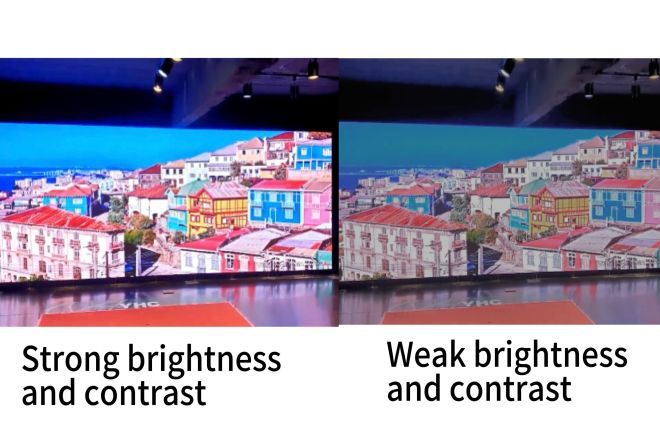
When the LED display screen has insufficient luminosité and contrast, the picture of the entire screen will appear dim, the color is not bright enough, and the distinction between the bright and dark parts of the image is not obvious, resulting in a blurred picture.
In this case, even high-resolution content may be difficult to recognize due to the loss of details, especially in a strong light environment; the content on the screen can hardly be seen clearly. Such a display effect will greatly reduce the audience’s viewing experience and make information communication difficult.
For the problem of insufficient brightness and contrast of LED display screens, the following strategies can be adopted for improvement and optimization:
1). Improve the quality of light sources
Select high-quality LED chips: When purchasing LED display screens, give priority to using well-known brands and high-luminous efficiency LED chips, which usually have better stability and longer service life.
Regular maintenance and replacement: Establish a regular maintenance plan to replace aging LED lamp beads in time to avoid affecting the overall brightness. At the same time, regularly check the circuit connection to ensure that each LED lamp bead can emit light normally.
2). Improve the control system
Optimize the brightness and contrast adjustment function: Upgrade or update the control system of the display screen to ensure that it has perfect brightness and contrast adjustment functions. Use software algorithms to achieve more refined adjustments to meet the needs of different application scenarios.
Professional training and settings: Provide professional training for operators to ensure that they can correctly set and use the brightness and contrast adjustment functions. At the same time, pre-set in advance according to the actual application scenario to avoid poor display effects caused by improper settings.
3). Comprehensive solution
Comprehensive evaluation and selection: Before purchasing an LED display screen, comprehensively evaluate the application scenario, ambient light conditions, viewing distance, and other factors to select a suitable display model and configuration.
System integration and debugging: After the display is installed, system integration and overall debugging are carried out to ensure that the various components work together to achieve the best display effect.
Continuous monitoring and optimization: During use, the display’s performance indicators, such as brightness, contrast, color reproduction, etc., are continuously monitored, optimized, and adjusted as needed to ensure that the display always maintains a good display effect.
2. The color reproduction of the LED display is poor
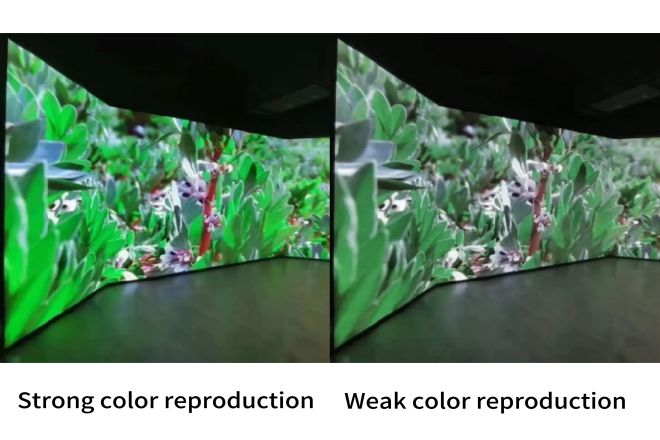
If the color reproduction of the LED display is poor, then when the picture is displayed, the color on the screen will be significantly different from the color of the original image. Specifically, the color may be too bright or dim, the tone may be warm or cold, and the color saturation may be insufficient or oversaturated.
This color deviation will cause the image to look unnatural, lose the original color level and details, and affect the audience’s visual experience.
Especially in scenes where accurate color presentation is required, such as art exhibitions, film, and television broadcasts, the problem of poor color reproduction will be more prominent, seriously affecting the display effect.
In view of the problem of poor color reproduction of LED display screens, improvements and optimizations can be made from the following aspects:
1). Optimize pixel spacing et distance de visualisation
- Reasonably design pixel spacing:
Select a suitable pixel spacing according to the application scenario and viewing distance. For close-up viewing, a display screen with a smaller pixel pitch should be selected to improve color fineness; for long-distance viewing, the pixel pitch can be appropriately increased to reduce costs.
- Dynamically adjust the viewing experience:
On some occasions, such as exhibitions or billboards, you can consider setting up multiple viewing areas and using different display screens or display technologies to meet the needs of viewers at different distances.
2). Improve color depth and grayscale
- Upgrade display technology:
Use LED chips with higher color depth and grayscale to support richer colors and more delicate pictures. This usually requires more advanced production processes and higher cost investment.
- Data processing optimization:
Optimize the software level of the display system to improve color reproduction and detail expression through algorithms. For example, advanced color interpolation algorithms can be used to fill in the color transition between pixels.
- Content adaptation:
Ensure that the content input to the LED display has sufficient color depth and grayscale information to give full play to the performance of the display.
3). Other comprehensive measures
- Ambient light control:
Control the light conditions of the environment around the LED display to reduce the impact of external light on the color of the display. You can use a hood or adjust the indoor lighting to optimize the viewing environment.
- Entretien régulier :
Clean and maintain the LED display screen regularly, and check and replace aging LED lamp beads and other key components to keep the display screen in optimal working condition.
- Quality monitoring:
Establish a complete quality monitoring system, strictly control each link in the production process, and ensure that the product meets quality standards and color requirements.
3. Limited viewing angle of the LED display screen
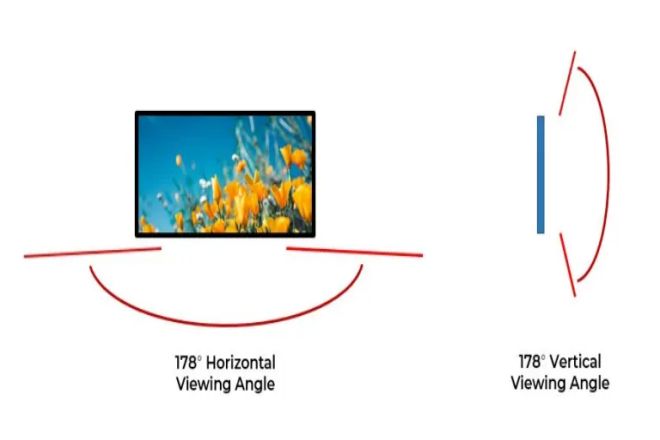
Quand le angle de vue of the LED display screen is limited, the audience will obviously feel the brightness and color quality of the screen on the screen gradually decrease after deviating from the optimal viewing position.
Specifically, the picture may become dim, the color will be distorted or faded, and the details will become blurred and difficult to recognize. Especially when the angle deviates at a large angle, the entire picture may become almost unwatchable, seriously affecting the audience’s visual experience.
Therefore, in front of the LED display screen with limited viewing angles, the audience needs to try to stay in the best viewing position to obtain the best visual effect.
The problem of the limited viewing angle of the LED display screen can be solved and optimized from the following aspects:
1). Improve LED packaging technology
- Use wide-view packaging technology:
Choose LED display screens that use wide-view packaging technology.
These screens take into account the angle of light scattering during design and manufacturing and can provide a larger viewing angle in the horizontal and vertical directions, reducing the brightness and color attenuation when the audience deviates from the optimal viewing angle.
- Optimize the packaging structure:
By improving the packaging structure of the LED, such as using special lens design or surface treatment technology, the scattering angle of the light can be increased, and the viewing angle range of the display screen can be improved.
2). Reasonably design the curvature of the screen
- Use curved design:
According to the specific application scenario and audience distribution, the curvature of the LED display screen can be reasonably designed. The curved screen can better adapt to the visual habits of the human eye, provide a wider viewing angle and a more comfortable viewing experience.
- Conception personnalisée :
For specific application scenarios, such as theaters, stadiums, etc., customized design can be carried out to adjust the curvature and shape of the display screen according to the distribution and shape of the audience seats to achieve the best viewing effect.
3). Reduce ambient light interference
- Add shading facilities:
In outdoor applications, add shading facilities such as awnings and shading nets to reduce the interference of direct sunlight on the display screen. These facilities can not only reduce the reflected light on the screen surface but also improve the contrast and clarity of the display.
- Use anti-reflective materials:
Select screen materials with anti-reflective properties to reduce the reflection of ambient light on the screen surface and improve the viewing angle and clarity of the display.
4). Other comprehensive measures
- Optimize pixel arrangement and spacing:
Through fine pixel arrangement and reasonable pixel spacing setting, it can ensure that the picture can maintain clarity and detail expression when viewed at different angles. Avoid using too large pixel spacing to reduce the visual impact of graininess.
- Use advanced image processing technology:
Optimize the image through image processing algorithms to enhance the contrast and color saturation of the picture so that the picture can present a more vivid and vivid visual effect at different angles.
- Reasonable installation position and angle adjustment:
When installing the LED display, it should be reasonably laid out according to the actual viewing needs and site conditions to ensure that the screen can cover as many audience areas as possible. At the same time, by adjusting the installation angle and inclination of the screen, the viewing effect at different angles can be further optimized.
4. Improper maintenance and care of the LED display
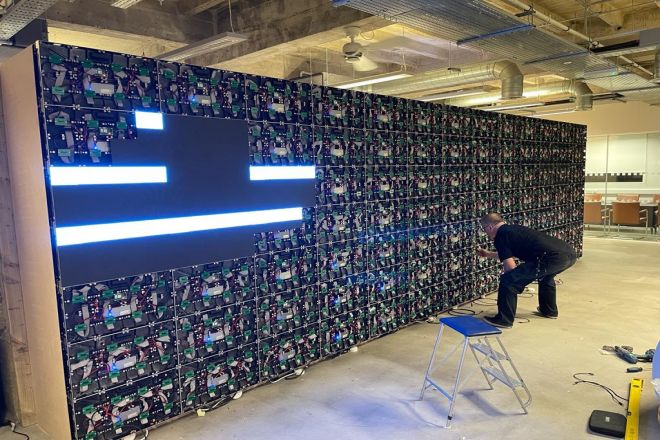
If the LED display is not properly maintained and cared for, its display screen may gradually have a variety of problems. First, dust and dirt may accumulate on the screen surface, resulting in reduced light transmittance and dim and unclear images.
Second, since the heat dissipation system may be blocked or malfunctioned, the LED lamp beads may reduce the luminous efficiency due to overheating, further affecting the brightness and color performance of the picture.
In addition, the lack of regular electrical performance inspections and structural stability maintenance may cause the display screen to have faults such as flickering, black screens, or image distortion, which seriously affects the viewing experience.
In the long run, these problems may also accelerate the aging process of the display screen and shorten its service life. Therefore, proper maintenance and care are essential to maintain a good display effect and extend the service life of the LED display screen.
For the problem of improper maintenance and care of LED display screens, it can be solved and optimized from the following aspects:
1). Regular cleaning
Importance: After long-term use, dust and dirt will accumulate on the surface of the LED display screen. These impurities will block the light from penetrating, reduce the display effect, and may accelerate the aging of the screen.
1.1). Solution strategy:
Regular cleaning plan: Develop a regular cleaning plan and determine the cleaning cycle according to the use environment and frequency. It is generally recommended to clean at least once a month, and the cleaning frequency should be higher for displays in highly polluted environments.
Professional cleaning method: Use a soft, lint-free cotton cloth or a non-shedding paper towel, gently dip it in clean water (avoid using detergents containing alcohol or chemical ingredients), wring it dry, and wipe the display. Be careful not to squeeze or scratch the surface of the screen.
Clean environment: Move the display to a place with good natural light for cleaning so that the dust can be seen more clearly and removed effectively.
2). Heat dissipation system maintenance
Importance: LED display screens generate a lot of heat when working. If the heat dissipation system fails, it will cause the temperature of the LED lamp beads to be too high, affecting the luminous efficiency, shortening the life, and even causing safety accidents.
2.1). Solution strategy:
Regularly check the heat dissipation system: Regularly check whether the heat dissipation components such as heat dissipation fans and heat sinks are operating normally, clean dust and debris, and ensure that the heat dissipation channel is unobstructed.
Optimize heat dissipation design: For display screens with poor heat dissipation performance, you can consider adding heat dissipation components, optimizing heat dissipation layout, or adopting more efficient heat dissipation technology.
Control ambient temperature: Place the display screen in a well-ventilated and temperature-appropriate environment, and avoid long-term high-power operation to reduce the heat dissipation burden.
3). Inspection et entretien réguliers
Importance: Lack of regular electrical performance inspection, structural stability inspection, software update, and other maintenance measures will lead to the gradual decline of display performance and ultimately affect the display effect and service life.
3.1). Solution strategy:
Develop a maintenance plan: According to the use of the display and the manufacturer’s recommendations, develop a detailed maintenance plan, including inspection content, cycle and method.
Electrical performance inspection: Regularly check whether the power supply, control card, signal line and other electrical components of the display are working properly, and promptly discover and repair potential fault hazards.
Structural stability inspection: Check whether the structural components such as the bracket and frame of the display are firm and reliable to prevent safety accidents caused by loose or damaged structure.
Software update: Pay attention to the software update information of the display in a timely manner, and upgrade the software according to the manufacturer’s guidance to improve the performance and stability of the display.
Conclusion
In summary, the reasons for the poor feedback effect of LED display screens mainly include insufficient brightness and contrast, poor color reproduction, limited viewing angles, and improper maintenance and care.
In response to these problems, manufacturers need to strengthen quality control and technological innovation in all aspects of product design, production, installation, and post-maintenance.
At the same time, users should also pay attention to the reasonable use and maintenance of the display screen to give full play to the superior performance of the LED display screen and improve the efficiency of information dissemination and visual experience.
Enfin, si vous souhaitez en savoir plus sur les écrans d'affichage LED, veuillez nous contacter.
